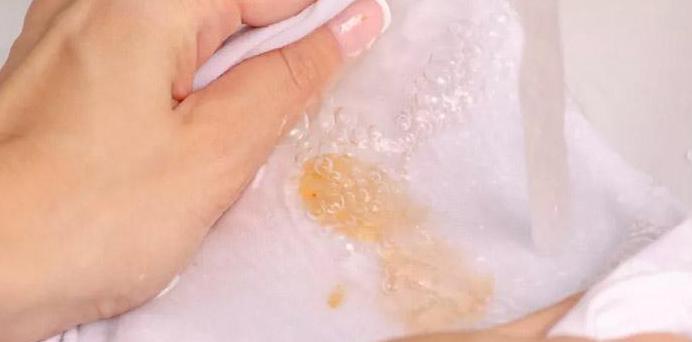
An Expert's Guide on How to Remove Oil Stains From Clothes
From pizza grease to coconut oil, don’t throw your best shirt away! With the right tools, removing oil stains from clothing isn't as hard as you think!
Oil stains can leave the most unsightly marks on your favorite clothing. Whether it’s pizza grease or coconut oil, you don’t have to toss your best blouse into the trash just because of a little stain. Below, we share how to remove oil stains from clothes. It’s not as tricky as you may think.
Why are Oil and Grease Stains so Tough?
Oil and grease don’t mix or break down with water since both are hydrophobic, which is tough since the main way we wash our clothes is in water. Oil stains are also hard to see on wet clothes, so you may not be able to tell if it’s really gone after washing.
One of the more trying parts of removing a stain is if you need the clothing right away. A little patience here is a must since running the stained fabric through the dryer before fully getting the stain out makes it harder to remove.
How to Get Rid of Oil Stains

Pretreating your stained fabric is the name of the game when it comes to getting out tough oil stains. To remove the stain and keep your fabric looking new, you’ll want to use these quick tips for getting rid of oil stains without having to make a trip to the dry cleaner:
- Treat as quickly as possible -- the longer it sets, the harder the removal.
- Work on the stain while it’s dry. Don’t rinse with water first!
- Blot the stain; don’t rub!
What You’ll Need:
Steps:
- Gently blot the stain with liquid dishwashing soap. Wait and let it sit for up to 10 minutes.
- Rinse the stain with cool water.
- Pre-treat the area with stain remover. Spray and let it sit for up to 15-20 minutes.
- For stains such as grease or lipstick, you can absorb the grease using an ultra-absorbent material such as chalk.
- Launder the garment according to its fabric care instructions or manufacturer’s fabric guide.
- If the stain remains, repeat steps 1-4.
- Do not place item in dryer unless the stain is completely removed. For safest results, air dry the item.
Pro tip: For motor oil stains or other stains with strong odors, you can first deodorize the area using baking soda, letting it sit for up 10 minutes before scraping it off. Bleach can damage fabrics or irritate sensitive skin, so look into safer alternatives, such as vinegar or dry steam vapor.
Can’t put your fabric in the washing machine? Follow these steps:

Step 1: Use the same instructions as above for “normal use” on fabrics.
Step 2: To rinse, fill a bowl with warm water, then saturate a clean cloth with the water.
Step 3: Gently wring the fabric, then press into the stain and move back and forth with light pressure. This will pull the stain remover from the surface, mimicking a rinsing effect.
Step 4: Rinse your cloth and repeat the same steps until the stain remover is "rinsed" from the surface.
Pro tip: Avoid using bleach to whiten clothes, as you risk chemical burns, accidental poisoning, and environmental damage. Instead, look into alternatives to bleach for whitening white clothes.
Frequently Asked Questions

How do I clean an oil stain if I can’t wash the item in a washing machine?
Follow these steps for non-machine washable fabrics.
1. Gentle blot the stain with dish soap and let it sit for up to 10 minutes.
2. Rinse the stain with warm water, then saturate a clean cloth with the water.
3. Gently wring the fabric, then press into the stain and move back and forth with light pressure. This will pull the stain remover from the surface, mimicking a rinsing effect.
4. Rinse your cloth and repeat the same steps until the stain remover is "rinsed" from the surface.
Can I remove grease stains once they’ve set deep into the fabric?
Even if you’ve run the fabric through the dryer, it’s still possible to remove the stain. However, it might be more difficult and could take several washing cycles.
- Spray on an enzyme-based stain remover.
- Next, agitate the affected area gently with a soft-bristled brush (a paint brush or makeup brush will work here), or by massaging the fabric together.
- Let it sit overnight, then wash the garment in the warmest water the fabric instructions recommend.
- If the stain is stubborn, repeat this process. Don’t put the garment into the dryer before the stain has been completely removed as heat will set stains deeper into the fabric.
Do oil stains require dry cleaning?
Some fabrics and stains may require professional services, but not all. If your fabric care instructions read “dry clean only,” then you’ll want to take your garment to a pro. If not, then try the tips above first to see if they eliminate the stain.
What ingredients should I look for when removing grease stains?
Grease is not water-soluble, so washing with traditional laundry detergent might not remove all of the grease and the stain can remain on your beloved clothing. For best results, use an enzyme-based stain remover. We also recommend washing your fabrics with a laundry soap that includes lipase in the ingredient list.
Are delicate fabrics ruined once a grease stain sets?
Since washing isn’t the most important thing to do when it comes to removing the grease, your delicate fabric may not be a lost cause. For old oil stains, apply an enzyme-based stain remover to get the toughest of stains out. Be sure to test for colorfastness in an inconspicuous area first. Don’t leave on silk or wool for more than one hour.
Do different types of oil need to be cleaned differently?
Generally, you’ll find most oil and grease stains will be cleaned the same way. Follow the instructions we mentioned above, and make sure you use a stain remover that includes lipase.
If it’s a solid fat, like avocado or butter, carefully scrape away the food with a spoon or spatula before pretreating the fabric with stain remover. The less of the oil source you have on your clothing, the easier it will be to get past to treat.


























